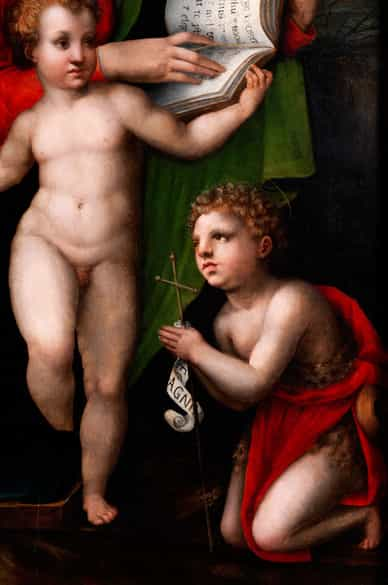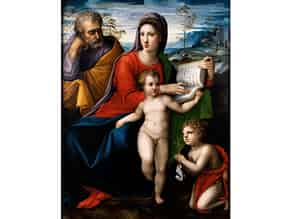Auction 16th - 18th century paintings
» reset
Your personal art agent

You are interested in works by Bartolomeo il Riccio Neroni?
We are happy to inform you, if works by Bartolomeo il Riccio Neroni are to be auctioned in one of our upcoming auctions.
Please accept our privacy policy
1241
Bartolomeo Neroni, Il Riccio,
um 1500 - um 1571, nachgewiesen in Siena
zwischen 1532 und 1571
HEILIGE FAMILIE MIT JOHANNESKNABEN Öl auf Holz.
113 x 89 cm.
Auf dem Gemälde ist eine mit Pinsel geschriebene, wahrscheinlich aus dem 19. Jahrhundert stammende Inschrift zu lesen „DALLE PRIME OPERE DI JACOPO DA PONTORMO FA.C 1525” und darunter eine moderne Inventarnummer „734 PH”.
Wir danken Prof. Filippo Todini, der sich mit dem Bild eingehend beschäftigte und es Bartolomeo Neroni, genannt „Il Riccio”, zuschrieb.
Dieses hervorragende, bestens erhaltene, noch unbekannte Gemälde ist ein hervorragendes Beispiel für die Werke der Sieneser Schule der zweiten Hälfte des 16. Jahrhunderts. Es könnte sich um eines der besten Werke von Bartolomeo Neroni handeln, vielleicht sogar um sein Meisterwerk. Vasari beschreibt ihn als einen „sehr erfahrenen und guten Maler”. „Il Riccio“ war einer der bedeutendsten Maler jener Phase, während in Siena (in unterschiedlichen Zeiträumen) Künstler wie Baldassarre Peruzzi (1481-1536), Sodoma (1477-1549), Domencio Beccafumi (1586-1551), Marco Pino (um 1520-1590) und Daniele da Volterra (1486-1551) arbeiteten. Mitte des Jahrhunderts, nach dem Tod von Sodoma (1549) und Beccafumi (1551), wurde Neroni zum Oberhaupt der örtlichen Kunstszene, zum „fast alleinigen Vorbild für eine ganze Generation”, dem „das Schicksal diese einigen wenigen, wichtigen Werke anvertraute“ (A. De Marchi, Domenico Beccafumi e il suo tempo, Ausstellungskatalog Siena, Mailand 1990, S. 366).
Das Werk spiegelt eine hohes malerisches, zeitgemäßes Kunstverständnis wieder. Neroni verbindet hier die Werke der großen vormaligen Meister der Sieneser Schule: Er erinnert an seinen Lehrer Sodoma, dessen einzige Tochter Faustina er geheiratet hatte, aber auch an Baldassare Peruzzi (1481-1536), wie es Giorgio Vasari (1511-1574) so richtig erkannte, mit den Hinterlassenschaften Raphaels (1483-1520) (besonders bei Perin del Vaga (1501-1547) und Giulio Romano (um 1499-1546)) und den Florentinern (Fra Bartolomeo (1472-1517) und Mariotto Albertinelli (1474-1515), aber auch den jüngeren Meistern wie Jacobo da Pontormo (1494-1556/57) und Michele di Ridolfo del Ghirlandaio(1503-1577)). Es gibt hier auffallende Ähnlichkeiten mit nachweisbaren Werken Neronis wie das Fresko des „Cristo e la samaritana al pozzo” (Christus und die Samariterin am Brunnen, entstanden, um 1540, für das Kloster San Girolamo in Campansi, Siena, das eindeutig von Sodoma und Peruzzi beeinflusst ist), das dieselben weichen, plastischen Formen, aber auch die Figuren und ihre verhaltenen Posen aufgreift; auch die Landschaft ist sehr ähnlich. Deutliche Analogien lassen sich außerdem beim Aufbau und der Physiognomie der Figuren und deren Größe feststellen. Hier sei auch auf das Strappo-Fresko der „Madonna col bambino, due santi e due angeli„ verwiesen, einem Fresko, das 1534 für den „Altare dei Muratori” im Dom von Siena entstand, heute jedoch im Museo dell'Opera del Duomo zu sehen ist und auf die spätere „Sacra famiglia con Giovannino e un angelo” der Sammlung Chigi Saracini, Siena. Betrachtet man all diese stilistischen Merkmale, dürfte unser Gemälde um 1550 entstanden sein. In jenen Jahren entwickelte Neroni seinen ganz eigenen Stil, da er sich nun von Sodoma und Peruzzi gelöst hatte und bereits jenes typisch akzentuierte Pathos, jene Art des noblen Deklamierens, der edel schlichten religiösen Rhetorik, zu verwenden wusste. (1081355) (21)
Catalogue price € 80.000 - 120.000
Catalogue price€ 80.000 - 120.000
$ 86,400 - 129,600
£ 72,000 - 108,000
元 625,600 - 938,400
₽ 7,959,200 - 11,938,800
Bartolomeo Neroni,
(also known as “Il Riccio”)
ca. 1500 - ca. 1571,
recorded in Siena between 1532 and 1571.
HOLY FAMILY WITH THE YOUNG SAINT JOHN THE BAPTIST
Oil on panel.
113 x 89 cm.
The paintbrush inscription “DALLE PRIME OPERE DI JACOPO DA PONTORMO FA.C 1525” [One of the first works by Jacopo da Pontormo created in 1525] was probably added later during the 19th century along with the modern inventory number “734 PH” beneath.
We would like to thank Professor Professor Filippo Todini, who studied the painting in detail and attributed it to Bartolomeo Neroni, also known as “Il Riccio”.
This magnificent, excellently preserved and until now unknown painting is a superb example of a work by the Sienese School of the second half of the 16th century. This could be one of Il Riccio’s best paintings - possibly even his masterpiece. Described by Vasari as a “very experienced and good painter”, Il Riccio was one of the most important painters in a period when artists such as Baldassarre Peruzzi, Sodoma, Beccafumi, Marco Pino and Daniele da Volterra. By the middle of the century following the deaths of Sodoma (1549) and Beccafumi (1551), Neroni became the figure head of the local art scene and “virtually the sole model for a whole generation”, to whom “fate entrusted the creation of a few important works” (A. De Marchi, Domenico Beccafumi e il suo tempo, exhibition catalogue Siena, Milan 1990, p. 366). There are obvious similarities between the offered lot and other verified works by Neroni such as the fresco of Christ and the Samaritan Woman at the Well created ca.1540 for the monastery San Girolamo in Campansi, Siena, itself clearly influenced by Sodoma and Peruzzi.
Reference should also be made to the “strappo” fresco of the Madonna and Christ Child with two Angels and two Saints created in 1534 for the Altare dei Muratori at Siena Cathedral, today at the Museo dell'Opera del Duomo, and the later painting The Holy Family with Saint John and an Angel in the Chigi Saracini Collection, Siena. Considering all its stylistic features this painting was probably created ca. 1550, a time when Neroni was in the process of developing his very own style.
The work shows a high appreciation for contemporary painting and art. Neroni combines works by former great masters of the Sienese School. The painting was probably created around 1550.
Neroni was in the process of developing his very own style in those years: he had now broken away from the style of Sodoma and Peruzzi and already knew how to employ his typical accentuated pathos, his manner of noble declamation and a classic, simple religious rhetoric.
This object has been individually compared to the information in the Art Loss Register data bank and is not registered there as stolen or missing.
Your personal art agent
You would like to be informed of upcoming auctions if a work by Bartolomeo il Riccio Neroni is offered? Activate your personal art agent here.
Please accept our privacy policy
You would like to purchase a work by Bartolomeo il Riccio Neroni?
Your personal art agent Purchase in Private Sale Calendar
Our experts are happy to support you personally in your search for art objects.
You would like to sell a work by Bartolomeo il Riccio Neroni?
Consign now Private Sale Service FAQ
Your consignments are always welcome.
Our staff will be happy to personally assist you every step of the way. We look forward to your call.
Get in touch with our experts




















